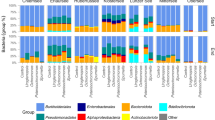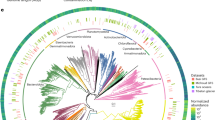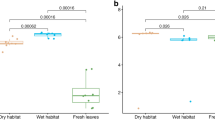Abstract
Glaciated alpine floodplains are responding quickly to climate change through shrinking ice masses. Given the expected future changes in their physicochemical environment, we anticipated variable shifts in structure and ecosystem functioning of hyporheic microbial communities in proglacial alpine streams, depending on present community characteristics and landscape structures. We examined microbial structure and functioning during different hydrologic periods in glacial (kryal) streams and, as contrasting systems, groundwater-fed (krenal) streams. Three catchments were chosen to cover an array of landscape features, including interconnected lakes, differences in local geology and degree of deglaciation. Community structure was assessed by automated ribosomal intergenic spacer analysis and microbial function by potential enzyme activities. We found each catchment to contain a distinct bacterial community structure and different degrees of separation in structure and functioning that were linked to the physicochemical properties of the waters within each catchment. Bacterial communities showed high functional plasticity, although achieved by different strategies in each system. Typical kryal communities showed a strong linkage of structure and function that indicated a major prevalence of specialists, whereas krenal sediments were dominated by generalists. With the rapid retreat of glaciers and therefore altered ecohydrological characteristics, lotic microbial structure and functioning are likely to change substantially in proglacial floodplains in the future. The trajectory of these changes will vary depending on contemporary bacterial community characteristics and landscape structures that ultimately determine the sustainability of ecosystem functioning.
Similar content being viewed by others
Log in or create a free account to read this content
Gain free access to this article, as well as selected content from this journal and more on nature.com
or
References
Acuna V, Wolf A, Uehlinger U, Tockner K . (2008). Temperature dependence of stream benthic respiration in an alpine river network under global warming. Freshwat Biol 53: 2076–2088.
Allison SD, Martiny JBH . (2008). Resistance, resilience, and redundancy in microbial communities. Proc Natl Acad Sci USA 105: 11512–11519.
Anderson MJ . (2001). A new method for non-parametric multivariate analysis of variance. Austral Ecol 26: 32–46.
Arpigny JL, Jaeger KE . (1999). Bacterial lipolytic enzymes: classification and properties. Biochem J 343: 177–183.
BAFU (2010) BAFU Annual Report. Federal Office for the Environment (FOEN): Geneva, Switzerland.
Battin TJ . (1999). Hydrologic flow paths control dissolved organic carbon fluxes and metabolism in an alpine stream hyporheic zone. Water Resour Res 35: 3159–3169.
Battin TJ, Wille A, Psenner R, Richter A . (2004). Large-scale environmental controls on microbial biofilms in high-alpine streams. Biogeosciences 1: 159–171.
Blanchet FG, Legendre P, Borcard D . (2008). Forward selection of explanatory variables. Ecology 89: 2623–2632.
Boucher D, Debroas D . (2009). Impact of environmental factors on couplings between bacterial community composition and ectoenzymatic activities in a lacustrine ecosystem. FEMS Microbiol Ecol 70: 66–78.
Boyer EW, Hornberger GM, Bencala KE, Mcknight DM . (1997). Response characteristics of doc flushing in an alpine catchment. Hydrol Process 11: 1635–1647.
Brown GH, Fuge R . (1998). Trace element chemistry of glacial meltwaters in an alpine headwater catchment. In: Kovar K (ed) Hydrology, Water Resources and Ecology in Headwaters. IAHS Press: Wallingford, pp 435–442.
Brown LE, Hannah DM, Milner AM . (2003). Alpine stream habitat classification: An alternative approach incorporating the role of dynamic water source contributions. Arct Antarct Alp Res 35: 313–322.
Bürgmann H, Jenni S, Vazquez F, Udert KM . (2011). Regime shift and microbial dynamics in a sequencing batch reactor for nitrification and anammox treatment of urine. Appl Environ Microbiol 77: 5897–5907.
Chevan A, Sutherland M . (1991). Hierarchical partitioning. Am Stat 45: 90–96.
Comte J, Del Giorgio PA . (2010). Linking the patterns of change in composition and function in bacterioplankton successions along environmental gradients. Ecology 91: 1466–1476.
Comte J, Del Giorgio PA . (2011). Composition influences the pathway but not the outcome of the metabolic response of bacterioplankton to resource shifts. PLoS One 6: e25266.
Crump BC, Kling GW, Bahr M, Hobbie JE . (2003). Bacterioplankton community shifts in an arctic lake correlate with seasonal changes in organic matter source. Appl Environ Microbiol 69: 2253–2268.
Deforest JL, Smemo KA, Burke DJ, Elliott HL, Becker JC . (2012). Soil microbial responses to elevated phosphorus and pH in acidic temperate deciduous forests. Biogeochemistry 109: 189–202.
Edwards RT, Meyer JL, Findlay SEG . (1990). The relative contribution of benthic and suspended bacteria to system biomass, production, and metabolism in a low-gradient blackwater river. J N Am Benthol Soc 9: 216–228.
Fierer N, Jackson RB . (2006). The diversity and biogeography of soil bacterial communities. Proc Natl Acad Sci USA 103: 626–631.
Findlay S . (1995). Importance of surface-subsurface exchange in stream ecosystems: the hyperheic zone. Limnol Oceanogr 40: 159–164.
Findlay S, Quinn JM, Hickey CW, Burrell G, Downes M . (2001). Effects of land use and riparian flowpath on delivery of dissolved organic carbon to streams. Limnol Oceanogr 46: 345–355.
Findlay S, Sinsabaugh RL . (1999). Unravelling the sources and bioavailability of dissolved organic matter in lotic aquatic ecosystems. Mar Freshwat Res 50: 781–790.
Freimann R, Bürgmann H, Findlay SEG, Robinson CT . (2013). Response of lotic microbial communities to altered water source and nutritional state in a glaciated alpine floodplain. Limnol Oceanogr 58: 951–965.
Frey B, Kremer J, Rüdt A, Sciacca S, Matthies D, Lüscher P . (2009). Compaction of forest soils with heavy logging machinery affects soil bacterial community structure. Eur J Soil Biol 45: 312–320.
Füreder L . (2007). Life at the edge: habitat condition and bottom fauna of alpine running waters. Int Rev Hydrobiol 92: 491–513.
Grömping U . (2006). Relative importance for linear regression in R: the package relaimpo. J Stat Softw 17: 1–27.
Hall MHP, Fagre DB . (2003). Modeled climate-induced glacier change in glacier national park, 1850–2100. Bioscience 53: 131–140.
Hall RO, Meyer JL . (1998). The trophic significance of bacteria in a detritus-based stream food web. Ecology 79: 1995–2012.
Hendricks SP . (1993). Microbial ecology of the hyporheic zone: a perspective integrating hydrology and biology. J N Am Benthol Soc 12: 70–78.
Hodson A, Mumford P, Lister D . (2004). Suspended sediment and phosphorous in proglacial rivers: bioavailability and potential impacts upon the p status of ice-marginal receiving waters. Hydrol Process 18: 2409–2422.
Horton P, Schaefli B, Mezghani A, Hingray B, Musy A . (2006). Assessment of climate-change impacts on alpine discharge regimes with climate model uncertainty. Hydrol Process 20: 2091–2109.
IPCC (2007). Climate change 2007: the physical science basis. In: Solomon S, Qin D, Manning M, Chen Z, Marquis M, Averyt KB et al(eds) Contribution of Working Group I to the Fourth Assessment Report of the Intergovernmental Panel on Climate Change. Press CU: New York, NY, USA.
Kirchman DL . (1994). The uptake of inorganic nutrients by heterotrophic bacteria. Microb Ecol 28: 255–271.
Labhart TP . (1998). Geology of Switzerland.: Ott Verlag: Thun, Switzerland.
Langenheder S, Berga M, Östman O, Székely AJ . (2011). Temporal variation of β-diversity and assembly mechanisms in a bacterial metacommunity. ISME J 6: 1107–1114.
Langenheder S, Bulling MT, Solan M, Prosser JI . (2010). Bacterial biodiversity–ecosystem functioning relations are modified by environmental complexity. PLoS One 5: e10834.
Langenheder S, Lindström ES, Tranvik LJ . (2006). Structure and function of bacterial communities emerging from different sources under identical conditions. Appl Environ Microbiol 72: 212–220.
Logue JB, Robinson CT, Meier C, Van Der Meer JR . (2004). Relationship between sediment organic matter, bacteria composition, and the ecosystem metabolism of alpine streams. Limnol Oceanogr 49: 2001–2010.
Maisch M . (1988). The movements of glaciers and snow-lines since the 1850 advance in the canton of Graubunden, Switzerland. Die Veraenderungen der Gletscherflaechen und Schneegrenzen seit dem Hoechstand von 1850 im Kanton Graubunden (Schweiz) 70: 113–130.
Makoi JHJR, Ndakidemi PA . (2008). Selected soil enzymes: examples of their potential roles in the ecosystem. Afr J Biotechnol 7: 181–191.
Malard F, Tockner K, Ward JV . (1999). Shifting dominance of subcatchment water sources and flow paths in a glacial floodplain, Val Roseg, Switzerland. Arct Antarct Alp Res 31: 135–150.
Malard F, Tockner K, Ward JV . (2000). Physico-chemical heterogeneity in a glacial riverscape. Landscape Ecol 15: 679–695.
Mantel N . (1967). The detection of disease clustering and a generalized regression approach. Cancer Res 27: 209–220.
Milner AM, Brown LE, Hannah DM . (2009). Hydroecological response of river systems to shrinking glaciers. Hydrol Process 23: 62–77.
Milner AM, Petts. GE . (1994). Glacial rivers: physical habitat and ecology. Freshwat Biol 32: 295–307.
Oksanen J, Blanchet FG, Kindt R, Legendre P, O'hara RB, Simpson GL et al (2011) Vegan: Community ecology, r package version 1: 17–6; http://cran.R-project.Org/package=vegan.
Olapade OA, Leff LG . (2005). Seasonal response of stream biofilm communities to dissolved organic matter and nutrient enrichments. Appl Environ Microbiol 71: 2278–2287.
Olapade OA, Leff LG . (2006). Influence of dissolved organic matter and inorganic nutrients on the biofilm bacterial community on artificial substrates in a northeastern Ohio, USA, stream. Can J Microbiol 52: 540–549.
Peres-Neto PR, Legendre P, Dray S, Borcard D . (2006). Variation partitioning of species data matrices: estimation and comparison of fractions. Ecology 87: 2614–2625.
Pernthaler J, Glöckner FO, Schönhuber W, Amann R . (2001). Fluorescence in situ hybridization (FISH) with rRNA-targeted oligonucleotide probes. In: Paul JH (ed.) Methods in Microbiology. Academic Press: New York, NY, pp 207–226.
Porter KG, Feig YS . (1980). The use of dapi for identifying and counting aquatic microflora. Limnol Oceanogr 25: 943–948.
R development core team (2012) R: A language and environment for statistical computing. R foundation for statistical computing. R development core team: Vienna, Austria, http://www.R-project.org/.
Robarge W . (2008). Acidity. In: Chesworth W (ed.) Encyclopedia of Soil Science. Springer: Netherlands, pp 10–21.
Robinson CT, Hieber M, Wenzelides V, Lods-Crozet B . (2007). Macroinvertebrate assemblages of a high elevation stream/lake network with an emphasis on the chironomidae. Fundam Appl Limnol 169: 25–36.
Robinson CT, Kawecka B . (2005). Benthic diatoms of an alpine stream/lake network in Switzerland. Aquat Sci 67: 492–506.
Robinson CT, Matthaei S . (2007). Hydrological heterogeneity of an alpine stream–lake network in Switzerland. Hydrol Process 21: 3146–3154.
Romaní AM, Giorgi A, Acuña V, Sabater S . (2004). The influence of substratum type and nutrient supply on biofilm organic matter utilization in streams. Limnol Oceanogr 49: 1713–1721.
Schofield RK, Taylor AW . (1955). The measurement of soil pH. Soil Sci Soc Am J 19: 164–167.
Schmidt S, Weber B, Winiger M . (2009). Analyses of seasonal snow disappearance in an alpine valley from micro- to meso-scale (Loetschental, Switzerland). Hydrol Process 23: 1041–1051.
Sekar R, Nair KVK, Rao VNR, Venugopalan VP . (2002). Nutrient dynamics and successional changes in a lentic freshwater biofilm. Freshwat Biol 47: 1893–1907.
Selinummi J, Seppälä J, Yli-Harja O, Puhakka JA . (2005). Software for quantification of labeled bacteria from digital microscope images by automated image analysis. Biotechniques 39: 859–862.
Shen J, He J . (2011). Responses of microbes-mediated carbon and nitrogen cycles to global climate change. Acta Ecol Sin 31: 2957–2967.
Simon J, Blott KP . (2001). Gradistat: a grain size distribution and statistics package for the analysis of unconsolidated sediments. ESPL 26: 1237–1248.
Sinsabaugh RL, Antibus RK, Linkins AE . (1991). An enzymic approach to the analysis of microbial activity during plant litter decomposition. Agric Ecosyst Environ 34: 43–54.
Sinsabaugh RL, Lauber CL, Weintraub MN, Ahmed B, Allison SD, Crenshaw C et al (2008). Stoichiometry of soil enzyme activity at global scale. Ecol Lett 11: 1252–1264.
Smith BPG, Hannah DM, Gurnell AM, Petts GE . (2001). A hydrogeomorphological context for ecological research on alpine glacial rivers. Freshwat Biol 46: 1579–1596.
Stanford JA, Ward JV . (1993). An ecosystem perspective of alluvial rivers: connectivity and the hyporheic corridor. J N Am Benthol Soc 12: 48–60.
Strickland MS, Lauber C, Fierer N, Bradford MA . (2009). Testing the functional significance of microbial community composition. Ecology 90: 441–451.
Swiss climate change scenarios CH2011 (2011) C2SM M, ETH Zurich. NCCR Climate, OcCC (publishers): Zurich.
Theurillat JP, Guisan A . (2001). Potential impact of climate change on vegetation in the european alps: a review. Clim Change 50: 77–109.
Tockner K, Malard F, Burgherr P, Robinson CT, Uehlinger U, Zah R et al (1997). Physico-chemical characterization of channel types in a glacial floodplain ecosystem (Val Roseg, Switzerland). Arch Hydrobiol 140: 433–463.
Tockner K, Malard F, Uehlinger U, Ward JV . (2002). Nutrients and organic matter in a glacial river–floodplain system (Val Roseg, Switzerland). Limnol Oceanogr 47: 266–277.
Uehlinger U, Robinson CT, Hieber M, Zah R . (2010). The physico-chemical habitat template for periphyton in alpine glacial streams under a changing climate. Hydrobiologia 657: 107–121.
Vihinen M, Mäntsälä P . (1989). Microbial amylolytic enzymes. Crit Rev Biochem Mol Biol 24: 329–418.
Ward JV . (1994). Ecology of alpine streams. Freshwat Biol 32: 277–294.
Wilczek S, Fischer H, Pusch MT . (2005). Regulation and seasonal dynamics of extracellular enzyme activities in the sediments of a large lowland river. Microb Ecol 50: 253–267.
Wood SN . (2006) Generalized Additive Models: An Introduction with R. Chapman & Hall: Boca Raton, FL, USA.
Yannarell AC, Kent AD, Lauster GH, Kratz TK, Triplett EW . (2003). Temporal patterns in bacterial communities in three temperate lakes of different trophic status. Microb Ecol 46: 391–405.
Zah R, Uehlinger U . (2001). Particulate organic matter inputs to a glacial stream ecosystem in the swiss alps. Freshwat Biol 46: 1597–1608.
Zemp M, Haeberli W, Hoelzle M, Paul F . (2006). Alpine glaciers to disappear within decades? Geophys Res Lett 33: L13504.
Acknowledgements
We thank the Swiss National Park for access rights to the Macun catchment, Simone Blaser and Christa Jolidon for field and laboratory assistance and the anonymous reviewers for their valuable comments and suggestions to improve the quality of the paper. This study was funded by the Swiss National Foundation (No. 31003A-119735).
Author information
Authors and Affiliations
Corresponding author
Ethics declarations
Competing interests
The authors declare no conflict of interest.
Additional information
Supplementary Information accompanies this paper on The ISME Journal website
Supplementary information
Rights and permissions
About this article
Cite this article
Freimann, R., Bürgmann, H., Findlay, S. et al. Bacterial structures and ecosystem functions in glaciated floodplains: contemporary states and potential future shifts. ISME J 7, 2361–2373 (2013). https://doi.org/10.1038/ismej.2013.114
Received:
Revised:
Accepted:
Published:
Issue date:
DOI: https://doi.org/10.1038/ismej.2013.114
Keywords
This article is cited by
-
Rare soil bacteria are more responsive in desertification restoration than abundant bacteria
Environmental Science and Pollution Research (2022)
-
Temperature-induced changes in biofilm organic matter utilization in arctic streams (Disko Island, Greenland)
Polar Biology (2021)
-
Bacterial community composition and function along spatiotemporal connectivity gradients in the Danube floodplain (Vienna, Austria)
Aquatic Sciences (2020)
-
A global synthesis of biodiversity responses to glacier retreat
Nature Ecology & Evolution (2019)
-
Microbial Organic Matter Utilization in High-Arctic Streams: Key Enzymatic Controls
Microbial Ecology (2019)



